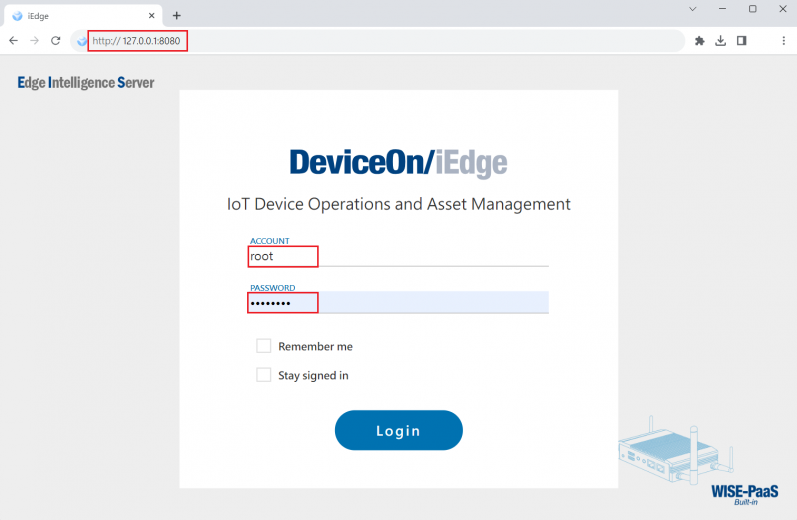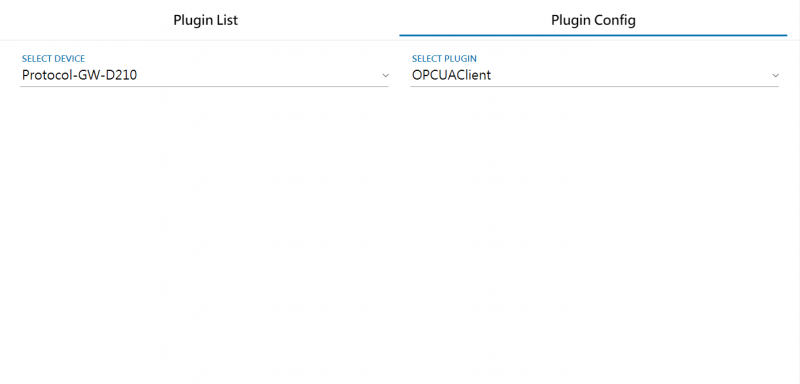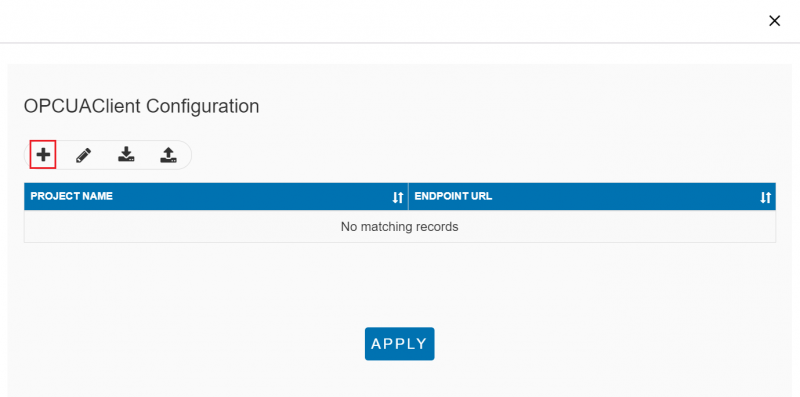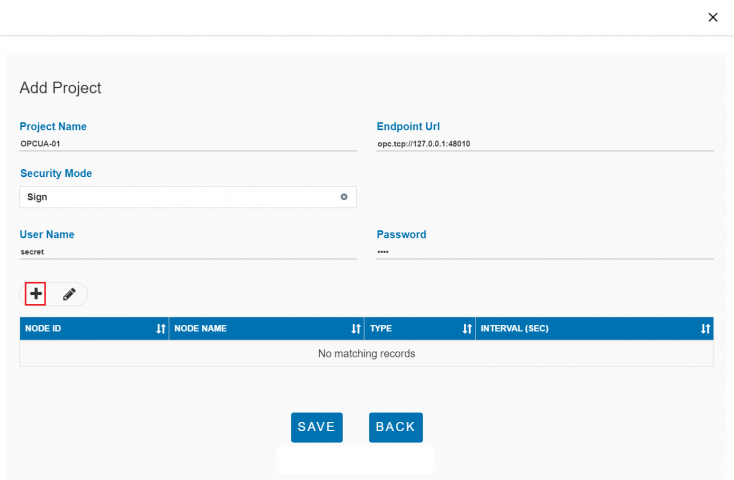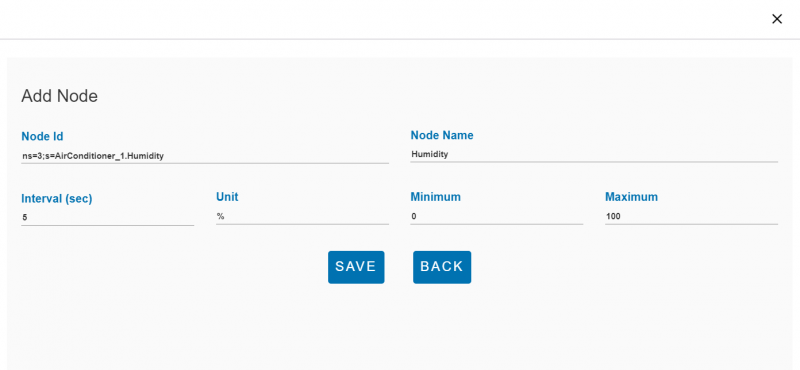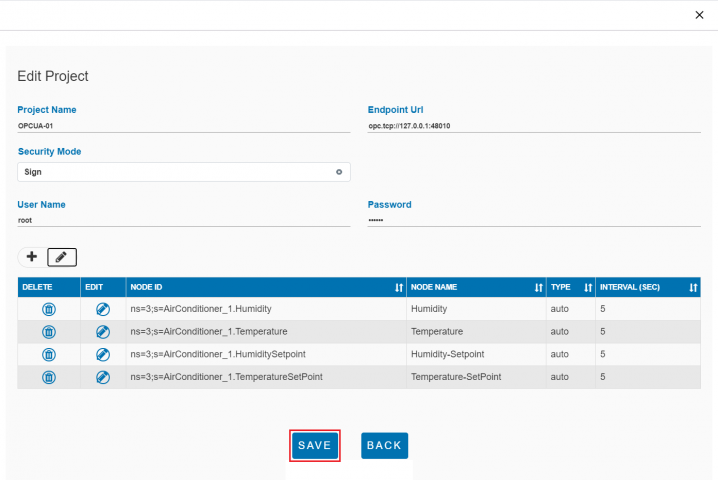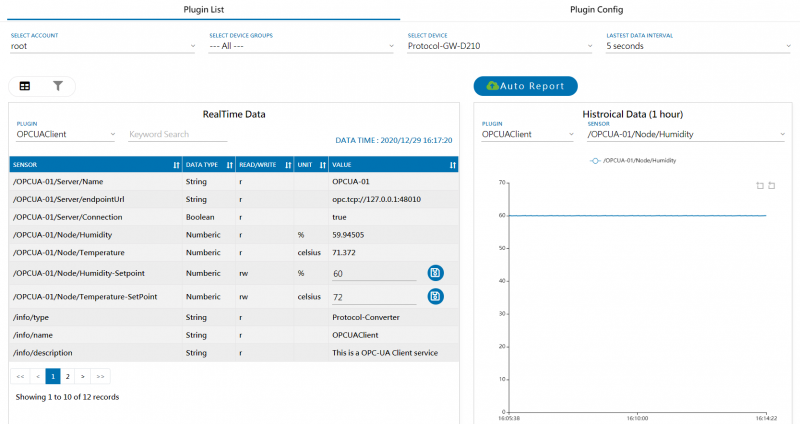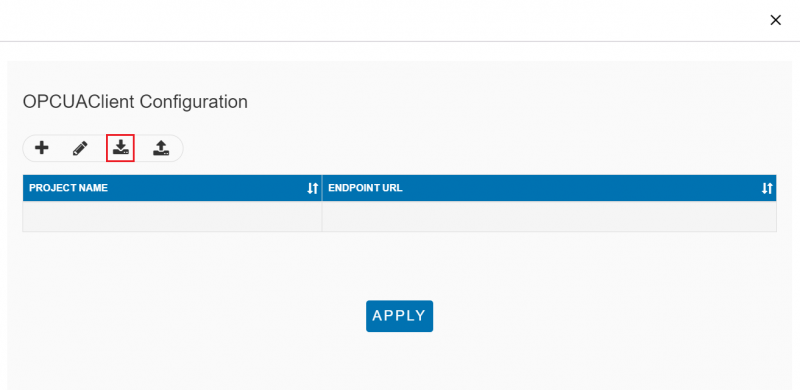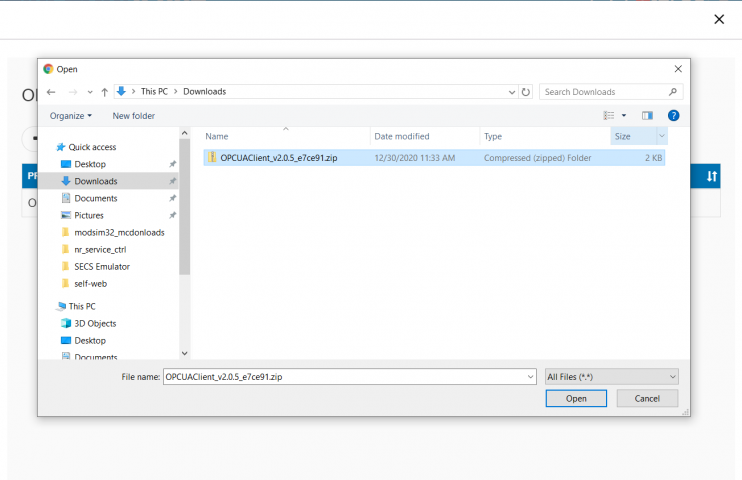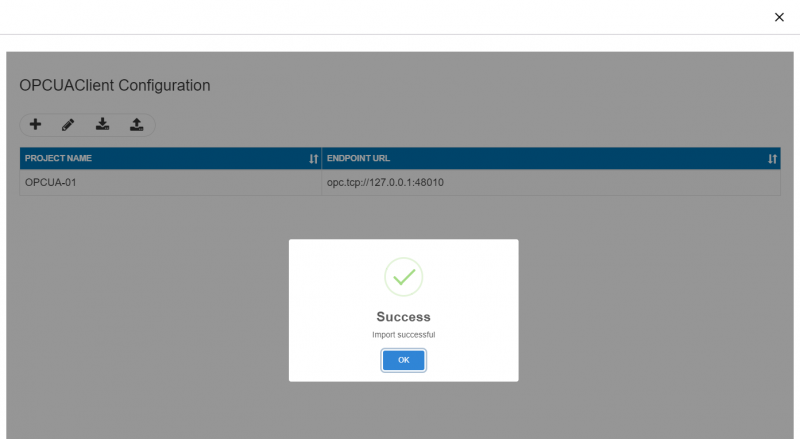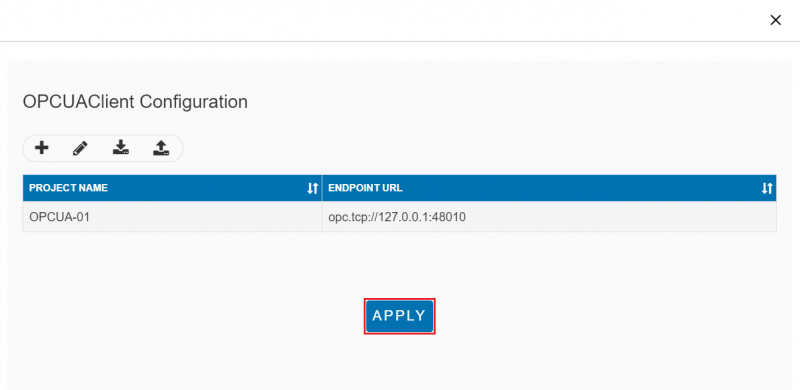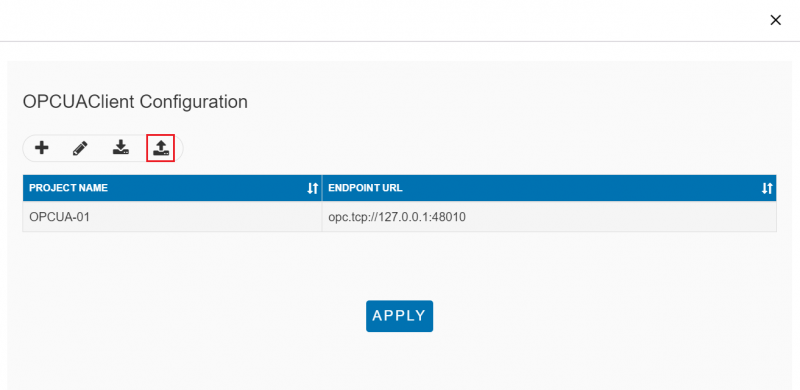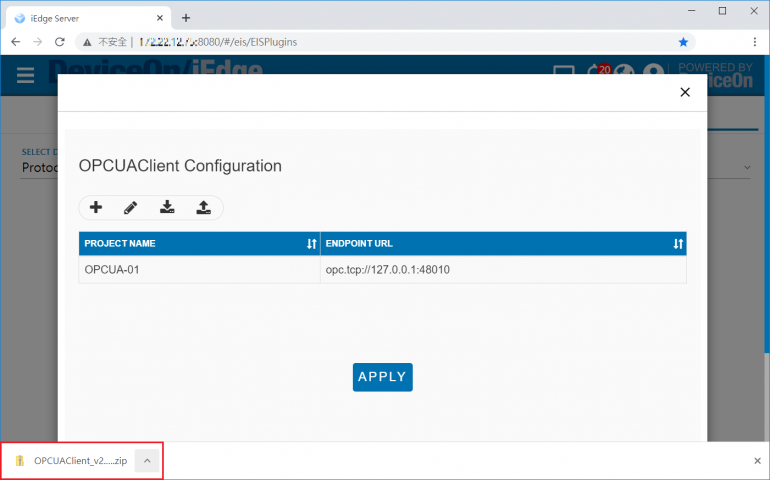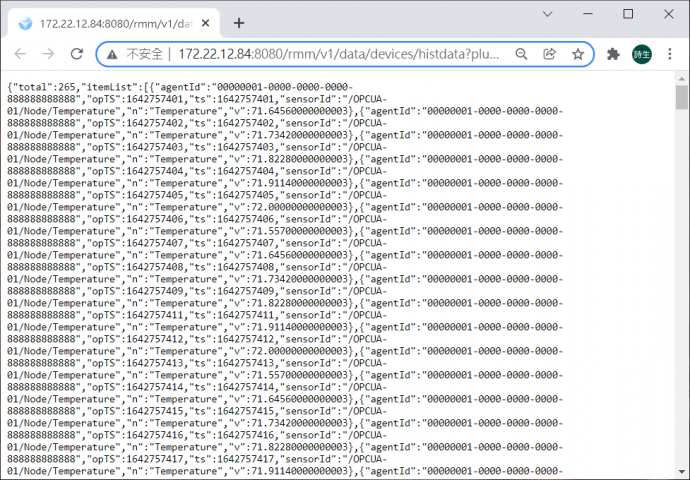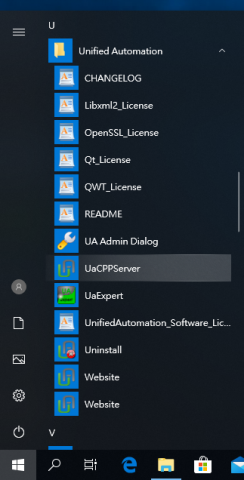|
|
| (6 intermediate revisions by one other user not shown) |
| Line 23: |
Line 23: |
| | = How to = | | = How to = |
| | | | |
| − | == Installation == | + | == Login == |
| | | | |
| − | '''Windows:''' | + | Step 1. Launch a web browser (Google Chrome, Microsoft Edge ...) and open iEdge local web '''http://127.0.0.1:8081''' |
| | | | |
| − | 1. Download OPC-UA Client for Windows from [http://ess-wiki.advantech.com.tw/view/OPC-UA_Client#Release Release] Table.
| + | Step 2. Login iEdge local web: |
| | | | |
| − | 2. Double click the installer to launch the installer to install it to the machine.
| + | Account: '''root''' |
| | | | |
| − |
| + | Password: '''P@ssw0rd''' |
| − | | |
| − | '''Debian:''' | |
| − | | |
| − | 1. Download OPC-UA Client for Debian from [http://ess-wiki.advantech.com.tw/view/OPC-UA_Client#Release Release] Table.
| |
| | | | |
| − | 2. Launch the installer to install it to the machine.
| + | [[File:Ros2-iedge-plugin-config-01.png|frameless|900x520px|Ros2-iedge-plugin-config-01.png]] |
| | | | |
| | | | |
| − |
| |
| − |
| |
| − | == Prepare OPCUA Demo Server ==
| |
| − |
| |
| − | Please follow below steps to setup OPCUA Demo Server:
| |
| − |
| |
| − | 1. Download Unified Automation C++ Demo Server from [https://www.unified-automation.com/downloads/opc-ua-servers.html https://www.unified-automation.com/downloads/opc-ua-servers.html] and install it to the server machine.
| |
| − |
| |
| − |
| |
| − | 2. Launch UaCppServer from Windows Start Menu.
| |
| − |
| |
| − | [[File:Opcua config POK0jrK.png|border|800x480px|Opcua config POK0jrK.png]]
| |
| − |
| |
| − | [[File:Uacpp-demo-server-01.png|800x480px|Uacpp-demo-server-01.png]]
| |
| − |
| |
| − |
| |
| − | 3. Information of OPCUA Demo Server, include Username/Password, Endpoint URL and Node IDs are shown in below.
| |
| − |
| |
| − |
| |
| − | {| border="1" cellpadding="1" cellspacing="1" style="width:500px;"
| |
| − | |-
| |
| − | | style="width: 220px;" | '''Username'''
| |
| − | | style="width: 267px;" | '''Password'''
| |
| − | |-
| |
| − | | style="width: 220px;" | root
| |
| − | | style="width: 267px;" | secret
| |
| − | |}
| |
| − |
| |
| − |
| |
| − |
| |
| − | {| border="1" cellpadding="1" cellspacing="1" style="width:500px;"
| |
| − | |-
| |
| − | | style="width: 217px;" | '''Endpoint URL Format'''
| |
| − | | style="width: 270px;" | opc.tcp://<Mancine Name or IP>:<Port>
| |
| − | |-
| |
| − | | style="width: 217px;" | '''Endpoint URL for this Demo'''
| |
| − | | style="width: 270px;" | opc.tcp://Protocol-Converter-GW:48010
| |
| − | |}
| |
| − |
| |
| − |
| |
| − |
| |
| − | {| border="1" cellpadding="1" cellspacing="1" style="width:500px;"
| |
| − | |-
| |
| − | | style="width: 217px;" | '''Node Nmae'''
| |
| − | | style="width: 270px;" | '''Node ID'''
| |
| − | |-
| |
| − | | style="width: 217px;" | AirConditioner_1.Humidity
| |
| − | | style="width: 270px;" | ns=3;s=AirConditioner_1.Humidity
| |
| − | |-
| |
| − | | style="width: 217px;" | AirConditioner_1.Temperature
| |
| − | | style="width: 270px;" | ns=3;s=AirConditioner_1.Temperature
| |
| − | |-
| |
| − | | style="width: 217px;" | AirConditioner_2.Humidity
| |
| − | | style="width: 270px;" | ns=3;s=AirConditioner_2.Humidity
| |
| − | |-
| |
| − | | style="width: 217px;" | AirConditioner_2.Temperature
| |
| − | | style="width: 270px;" | ns=3;s=AirConditioner_2.Temperature
| |
| − | |}
| |
| − |
| |
| | | | |
| | | | |
| Line 218: |
Line 155: |
| | <br/><br/> | | <br/><br/> |
| | | | |
| − | = Demonstration =
| |
| | | | |
| − | == Connect a Unified Automation C++ Demo Server == | + | = Appendix = |
| | + | |
| | + | == Install OPCUA Demo Server == |
| | + | |
| | + | Please follow below steps to setup OPCUA Demo Server: |
| | | | |
| | 1. Download Unified Automation C++ Demo Server from [https://www.unified-automation.com/downloads/opc-ua-servers.html https://www.unified-automation.com/downloads/opc-ua-servers.html] and install it to the server machine. | | 1. Download Unified Automation C++ Demo Server from [https://www.unified-automation.com/downloads/opc-ua-servers.html https://www.unified-automation.com/downloads/opc-ua-servers.html] and install it to the server machine. |
| Line 226: |
Line 166: |
| | | | |
| | 2. Launch UaCppServer from Windows Start Menu. | | 2. Launch UaCppServer from Windows Start Menu. |
| | + | |
| | + | [[File:Opcua config POK0jrK.png|border|800x480px|Opcua config POK0jrK.png]] |
| | | | |
| | [[File:Uacpp-demo-server-01.png|800x480px|Uacpp-demo-server-01.png]] | | [[File:Uacpp-demo-server-01.png|800x480px|Uacpp-demo-server-01.png]] |
| | | | |
| | | | |
| − | 3. Config OPC-UA Client to connect to the Unified Automation C++ Demo Server, Username/Password, Endpoint URL and Node IDs are shown in below. | + | 3. Information of OPCUA Demo Server, include Username/Password, Endpoint URL and Node IDs are shown in below. |
| | | | |
| | | | |
| Line 272: |
Line 214: |
| | | style="width: 270px;" | ns=3;s=AirConditioner_2.Temperature | | | style="width: 270px;" | ns=3;s=AirConditioner_2.Temperature |
| | |} | | |} |
| − |
| |
| − |
| |
| − |
| |
| − | 5. Verify OPCUAClient plugin data.
| |
| − |
| |
| − | = Release =
| |
| − |
| |
| − | <span style="font-size:larger;">This is an overview that displays OPC-UA Service versions and some stats and numbers for each release.</span>
| |
| − |
| |
| − | {| border="1" cellpadding="1" cellspacing="1" style="width: 1292px;"
| |
| − | |-
| |
| − | | style="width: 47px; text-align: center;" | <span style="font-size:larger;">Index</span>
| |
| − | | style="width: 63px; text-align: center;" | <span style="font-size:larger;">Version</span>
| |
| − | | style="width: 85px; text-align: center;" | <span style="font-size:larger;">Date</span>
| |
| − | | style="width: 78px; text-align: center;" | <span style="font-size:larger;">Platform</span>
| |
| − | | style="width: 109px; text-align: center;" | <span style="font-size:larger;">OS</span>
| |
| − | | style="width: 587px; text-align: center;" | <span style="font-size:larger;">Release Note</span>
| |
| − | | style="width: 286px; text-align: center;" | <span style="font-size:larger;">Installer</span>
| |
| − | |-
| |
| − | | style="width: 47px; text-align: center;" | <span style="font-size:larger;">1</span>
| |
| − | | style="width: 63px; text-align: center;" | <span style="font-size:larger;">v2.0.1</span>
| |
| − | | style="width: 85px; text-align: center;" |
| |
| − | <span style="font-size:medium;">2020/1/03</span>
| |
| − |
| |
| − | | style="width: 78px; text-align: center;" | <span style="font-size:larger;">x86_64 CPU</span>
| |
| − | | style="width: 109px; text-align: center;" | <span style="font-size:larger;">Windows</span>
| |
| − | | style="width: 587px;" |
| |
| − | <span style="font-size:medium;">1. Support Multiple OPCUA server.</span>
| |
| − |
| |
| − | <span style="font-size:medium;">2. Support Anonymous, Username/Password</span>security check.</span>
| |
| − |
| |
| − | <span style="font-size:medium;">3. Support individual node access interval configuration.</span>
| |
| − |
| |
| − | <span style="font-size:medium;">4. Configurable node alias.</span></span>
| |
| − |
| |
| − | <span style="font-size:larger;">[file://eossfs/ESS-Release/EdgeSense/Software/OPCUA_Client/Windows/2.0.1 OPCUA_Client_for_Windows_ReleaseNote_2.0.1.txt]</span>
| |
| − |
| |
| − | | style="width: 286px; text-align: center;" | <span style="font-size:larger;">[file://eossfs/ESS-Release/EdgeSense/Software/OPCUA_Client/Windows/2.0.1 device-opcua-client-2.0.1.exe]</span>
| |
| − | |-
| |
| − | | style="width: 47px; text-align: center;" | <span style="font-size: 15.6px;">2</span>
| |
| − | | style="width: 63px; text-align: center;" | <span style="font-size:larger;">v2.0.1</span>
| |
| − | | style="width: 85px; text-align: center;" |
| |
| − | <font size="3">Coming soon</font>
| |
| − |
| |
| − | | style="width: 78px; text-align: center;" |
| |
| − | <span style="font-size:larger;">ARM</span>
| |
| − |
| |
| − | <span style="font-size:larger;">CPU</span>
| |
| − |
| |
| − | | style="width: 109px; text-align: center;" | <span style="font-size: 15.6px;">Debian</span>
| |
| − | | style="width: 587px;" |
| |
| − | <span style="font-size:medium;">1. Support Multiple OPCUA server.</span>
| |
| − |
| |
| − | <span style="font-size:medium;">2. Support Anonymous, Username/Password security check.</span>
| |
| − |
| |
| − | <span style="font-size:medium;">3. Support individual node access interval configuration.</span>
| |
| − |
| |
| − | <span style="font-size:medium;">4. Configurable node alias.</span></span> [file://eossfs/ESS-Release/EdgeSense/Software/OPCUA_Client/Debian OPCUA_Client_for_Debian_ReleaseNote_2.0.1.txt]</span>
| |
| − |
| |
| − | | style="width: 286px; text-align: center;" | <span style="font-size:larger;">[file://eossfs/ESS-Release/EdgeSense/Software/OPCUA_Client/Debian device-opcua-client-2.0.1-Debian_9.9-rk3399.run]</span>
| |
| − | |-
| |
| − | | style="width: 47px; text-align: center;" | <span style="font-size:larger;">3</span>
| |
| − | | style="width: 63px; text-align: center;" | <span style="font-size:larger;">v2.0.2</span>
| |
| − | | style="width: 85px; text-align: center;" |
| |
| − | <span style="font-size:medium;">2020/3/31</span>
| |
| − |
| |
| − | | style="width: 78px; text-align: center;" | <span style="font-size:larger;">x86_64 CPU</span>
| |
| − | | style="width: 109px; text-align: center;" | <span style="font-size:larger;">Windows</span>
| |
| − | | style="width: 587px;" |
| |
| − | <span style="font-size:medium;">1. Support Web UI configuration.</span>
| |
| − |
| |
| − | <span style="font-size:medium;">2. Use AdvSC to control service life cycle.</span>
| |
| − |
| |
| − | <span style="font-size:larger;">[file://file://eossfs/ESS-Release/EdgeSense/Release/Windows/OPCUA_Client OPCUA_Client_for_Windows_ReleaseNote_2.0.2.txt]</span>
| |
| − |
| |
| − | | style="width: 286px; text-align: center;" | <span style="font-size:larger;">[file://eossfs/ESS-Release/EdgeSense/Release/Windows/OPCUA_Client device-opcua-client-2.0.2.exe]</span>
| |
| − | |-
| |
| − | | style="width: 47px; text-align: center;" | <span style="font-size:larger;">4</span>
| |
| − | | style="width: 63px; text-align: center;" | <span style="font-size:larger;">v2.0.3</span>
| |
| − | | style="width: 85px; text-align: center;" |
| |
| − | <span style="font-size:medium;">Coming Soon</span>
| |
| − |
| |
| − | | style="width: 78px; text-align: center;" | <span style="font-size:larger;">x86_64 CPU</span>
| |
| − | | style="width: 109px; text-align: center;" | <span style="font-size:larger;">Windows</span>
| |
| − | | style="width: 587px;" |
| |
| − | <span style="font-size:medium;">1. Support write node data.</span>
| |
| − |
| |
| − | <span style="font-size:medium;">2. Support read array type node data.</span>
| |
| − |
| |
| − | <span style="font-size:larger;">[file://eossfs/ESS-Release/EdgeSense/Release/Windows/OPCUA_Client OPCUA_Client_for_Windows_ReleaseNote_2.0.3.txt]</span>
| |
| − |
| |
| − | | style="width: 286px; text-align: center;" | <span style="font-size:larger;">[file://eossfs/ESS-Release/EdgeSense/Release/Windows/OPCUA_Client device-opcua-client-2.0.3.exe]</span>
| |
| − | |}
| |
| − |
| |
| − | <span style="font-size:larger;">Above files are available at local server, please paste file's url in File Explorer to copy file. ([[EdgeSense_FAQ|How to access to EOSSFS file server]] )</span>
| |
OPC Unified Architecture (OPC UA) is a machine to machine communication protocol for industrial automation developed by the OPC Foundation.
EdgeSense OPC-UA Client aims to collect data from OPC-UA Server and control.
Step 1. Launch a web browser (Google Chrome, Microsoft Edge ...) and open iEdge local web http://127.0.0.1:8081
Step 2. Login iEdge local web:
Please follow below steps to config OPCUAClient plugin to subscribe data from OPCUA Demo Server:
Step 1. Go to "Plug-ins" / Plugin Config to select OPCUAClient Plug-in
Setp 2. Click "+" to add OPCUA project
Setp 3. Edit new OPCUA Project
Step 5. Edit Node Information
Step 1. Click Import button from OPCUAClient Configuration
Step 1. Click Export button from OPCUAClient Configuration
